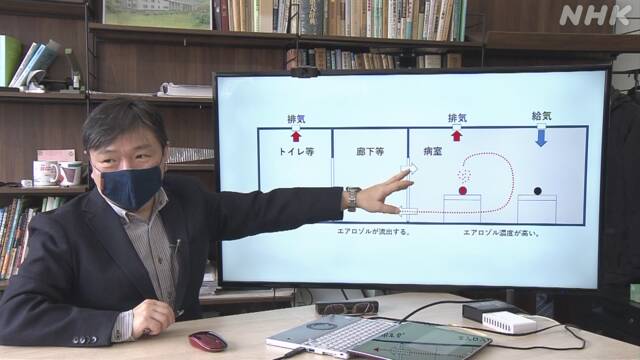A research group at Hokkaido University summarized the results of a survey of eight hospitals nationwide where new coronavirus clusters occurred from March last year to February, and found that ventilation was insufficient at four hospitals. I did.
The research group said, "It is undeniable that it may have contributed to the spread of the infection," and pointed out that it is necessary to investigate in detail whether hospitals in each region are well ventilated.
Professor Motoya Hayashi's research group at Hokkaido University visited eight hospitals nationwide where new coronavirus clusters occurred from March last year to February, and investigated how ventilation was performed. It was.
As a result, in the four hospitals, the equipment responsible for ventilation was
▽ deteriorated due to aging, etc.,
▽ stopped at night
, and
▽ stopped
regularly to save electricity. I found out.
In addition, when the research group conducted an analysis in a hospital room using fine particles and carbon dioxide that resembled the flying of an infected person, the flying air flow from the hospital room to the corridor was created by the air conditioning. In some cases, it scattered and spread, reaching the nurse station and other hospital rooms.
Regarding inadequate ventilation by equipment responsible for air conditioning and ventilation, the CDC = Centers for Disease Control and Prevention in the United States has pointed out that it can contribute to the spread of infection, and strengthening measures are required in each country. I will.
"It is undeniable that inadequate ventilation may have contributed to the spread of the infection," the research group said, pointing out that hospitals around the world should also investigate whether adequate ventilation is available.
Professor Hayashi says, "In addition to countermeasures against infections caused by contact and flying, I would like you to immediately check ventilation and take countermeasures."
How "ventilation" affects the spread of infection
This research is being carried out as part of the scientific research of the Ministry of Health, Labor and Welfare, and aims to determine how ventilation affects the spread of the new coronavirus infection.
In March of last year, the national expert meeting cited "a closed space with poor ventilation" as one of the conditions common to many clusters that occurred nationwide, and called for countermeasures as one of the so-called "three dense". It was.
However, there is no clear guideline on how much ventilation is sufficient, and the research group has been conducting a survey of more than 100 hospitals, stores, and other facilities nationwide since April last year in order to create guidelines. ..
The research group has investigated eight hospitals with clusters so far and found that four hospitals had insufficient ventilation, but did not disclose the hospital name.
Professor Hayashi said, "In old hospitals, it is more likely that there is insufficient ventilation. To prevent the spread of infection, hospital staff and managers should first grasp the current situation as soon as possible." I am.
“Hospitals do not have specific ventilation standards”
This time, the research group used the amount of ventilation set by the Japan Medical and Welfare Equipment Association as a guide.
It is an organization created by companies involved in the construction of university hospitals and hospitals, and it does not assume the new coronavirus, but it sets a guideline for the amount of ventilation that domestic hospitals should meet, for example, in general hospital rooms. , It is said that it is necessary to prepare air conditioning and ventilation equipment so that the air in the room is almost replaced twice an hour.
The reason why the research group adopted this guideline is that there is no national standard that specifically defines the amount of ventilation required for hospitals.
For general office buildings, etc., it is stipulated based on the "Building Sanitation Law", and the Ministry of Health, Labor and Welfare has indicated a guideline of "30 cubic meters per person per hour" as the amount of ventilation required for countermeasures against the new coronavirus. However, there is no concrete standard in hospitals based on these laws.
Professor Hayashi of the research group says, "Hospitals need to replace air more frequently than ordinary office buildings. We would like to clarify the amount of ventilation required in future research."
Ministry of Health, Labor and Welfare "Inspection of ventilation equipment"
In response to this survey result, the Ministry of Health, Labor and Welfare told medical institutions nationwide that treat patients with the new coronavirus, saying that "insufficient ventilation may have contributed to cluster infection in hospitals." I called for an inspection of the ventilation system.
The Ministry of Health, Labor and Welfare contacted local governments nationwide on the 7th in writing, citing the results of this survey by a research group at Hokkaido University, saying, "The amount of ventilation in the hospital is less than when it was designed. Factors that cause this to occur include aging ventilation equipment, energy conservation, and adjustments for cost savings. "
When it is confirmed that the appropriate ventilation volume cannot be secured,
▽ cleaning of the filter
,
▽
repair of aging ventilation equipment, etc. can be performed to improve the ventilation condition, or
▽ can be improved. As a countermeasure, I would like you to consider ventilation by opening the window.
We also want local governments to work together to make improvements when they receive consultations from medical institutions.

